Aloe vera is a perennial evergreen and succulent herb of the genus Aloe. It is native to the Mediterranean and Africa. At present, there are only 6 varieties of aloe vera plant that have been confirmed for use in cosmetics, namely Aloe Barbadensis, Aloe Andongensis, Aloe Perryi, Aloe Ferox, Aloe Arborescens, Aloe Chinensis Berger. The rest is ornamental ones. Polysaccharide is the main sugar compound of aloe; and it is also the main physiological active substance of aloe. Aloe is also rich in Anthraquinones (barbaloin, aloe-emodin, emodin, etc.). Additionally, aloe contains trace elements, amino acids, vitamins and phenols.
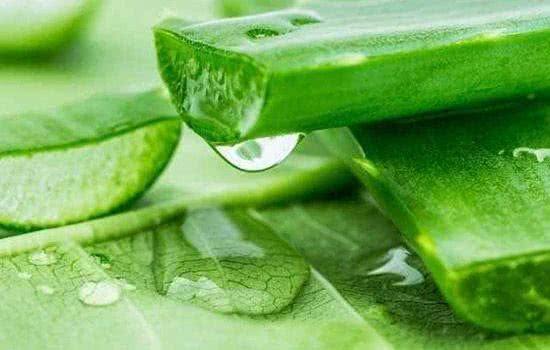 Aloe vera extract has been widely used in cosmetics industry. It is a natural ingredient with multiple skin care functions, such as moisturizing, sunscreen, soothing, sunburn repair as well as hair care. Cosmetics mainly are made of aloe vera fresh stems and leaves.
Aloe vera extract has been widely used in cosmetics industry. It is a natural ingredient with multiple skin care functions, such as moisturizing, sunscreen, soothing, sunburn repair as well as hair care. Cosmetics mainly are made of aloe vera fresh stems and leaves.
Aloe Vera Benefits in Cosmetics
- Moisturizing
Aloe vera contains aloe polysaccharides, amino acids and metal salts. They are the same as natural moisturizing factors, and have good moisturizing property. Aloe vera gel can provide a natural moisturizing system for skin. Experimental studies have shown that the optimum moisturizing concentration of aloe vera in emulsion system is 40%-50% (the content of aloe vera juice in the formulation). Its moisturizing property is better than hyaluronic acid and 5% glycerol. In a relatively dry environment (RH=43.3%), its moisture retention is even better than 10% glycerol.
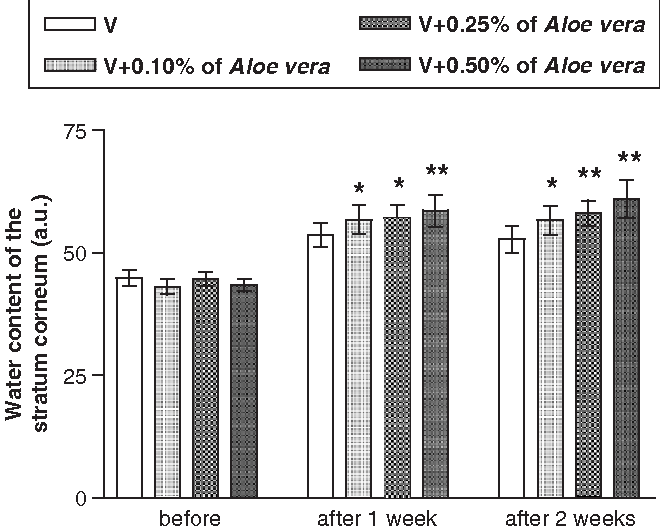
Figure: Effect of Aloe Extract on Cuticle Moisture Content
- Sun Block
The main component of sunscreen in aloe vera is anthraquinones (aloeidine). Due to the long conjugated system of anthraquinones, it has strong UV absorption capability in the ultraviolet region 320-380nm. The sun protection mechanism is that aloe vera absorbs ultraviolet light under the excitation of ultraviolet rays, and the electrons transition from the ground state to the excited state. When the electrons return to the ground state, the absorbed light is released in the form of fluorescence. That is to say, in this process, aloe vera absorbs ultraviolet energy and converts it into fluorescence that does not damage skin. The combination of aloe vera and silicone oil can form an adsorptive coating on skin surface, thus the active ingredient exerts a good sunscreen effect.
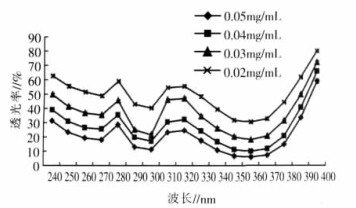
Figure: Light Transmittance of Aloeidine Content Sample
- Wound Healing
The wound healing process and immune stimulation of aloe vera are derived from the polysaccharides with higher molecular weight in the gel. The polysaccharides are mainly mannan. Mannan contains substances that can increase macrophages activity. The activation of macrophages accelerates the growth of cells and tissues, and increases the activity and proliferation rate of fibroblasts, thus promoting wound healing. Moreover, gibberellin, a kind of plant growth hormone, in aloe vera promotes wound healing by increasing the rate of protein synthesis.
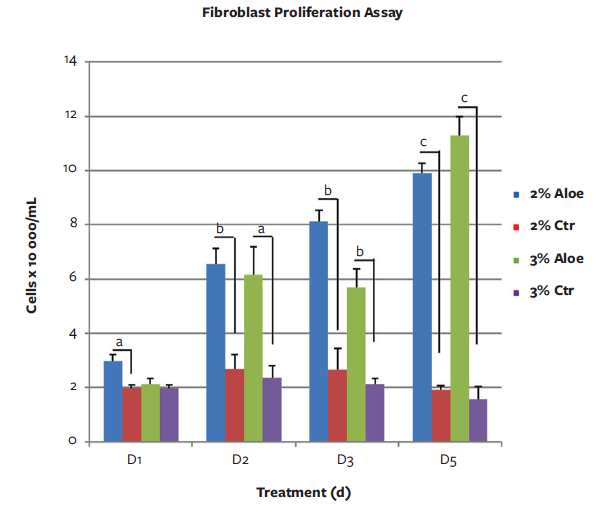
Figure: Aloe Extract Stimulates Proliferation of Fibroblasts
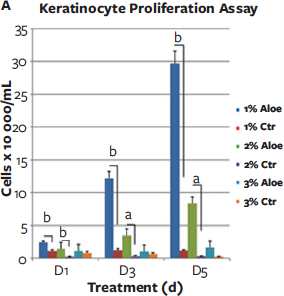
Figure: Aloe Extract Stimulates Proliferation of Keratinocytes
- Anti-inflammation
The anti-inflammatory effect of aloe vera is one of its most basic functions. Because it includes steroid, vasokinin and anti-prostaglandin, which has anti-inflammatory activity and can alleviate skin inflammation. Therefore, aloe vera extract has a great treatment for acne.
Plamed Green Science Group develops 2 specification aloe vera extract: Aloe Vera Gel Lyophilized Powder 100:1 and Aloe Vera Gel Lyophilized Powder 200:1. Both of them are white powder and of good water solubility. So Plamed Aloe Vera Gel Powder is suitable to be added in to all kinds of cosmetics formulation.
Aloe Vera Gel Application in Cosmetics
Plant Source: aloe vera leaves
INCI Name: ALOE VERA EXTRACT
Appearance: powder
Solubility: water solubility
pH Value: 3.5-5.0
Applicable Products: toner, cream, lotion, gel, shampoo, etc.
Functions: moisturizing, sun block, wound healing, anti-inflammation
Dosage: skin care cream: 3-4%; body wash and soap: 1.8-2%
Aloe Vera Uses in Cosmetics
- Add 0.5% Aloe Vera Gel Powder into 99.5% water. Heat to 77℃, and then add some preservative.
- Use in formulation: add 0.5% Aloe Vera Gel Powder to water phase. Keep for 20 minutes, then add other water phase materials.
Bottom Line
As a widely used natural cosmetic raw material, aloe vera extract has a permanent status in cosmetics industry. It has various skin care effects such as moisturizing, sunscreen, healing wounds and anti-inflammation. It is convenient to use in cosmetics and has remarkable effects.
Reference
Eric Teplicki et al. The Effects of Aloe vera on Wound Healing in Cell Proliferation, Migration, and Viability. 2018; 30 (9); 263-268.
L.Langmead et al. Anti-inflammatory effects of aloe vera gel in human colorectal mucosa in vitro. 2004.
Gomathi Periasamy et al. Cosmetic Use of Aloe Vera-a Review. 2014; 3(5); 342-458.
Lizelle T. Fox et al. In Vivo Skin Hydration And Anti-Erythema Effects Of Aloe Vera, Aloe Ferox And Aloe Marlothii Gel Materials After Single And Multiple Applications.
Plamed aims to develop natural cosmetics raw materials. Plamed Aloe Vera Extract is high content and low cost.
If you want to buy Aloe Vera Extract , please contact us in following way.

Rae Wong
Tel: +86-29-8821 5350
Mobile: +86 180 6683 3765
Email: sale@plamed.cn
Whatsapp: +86 180 6683 3765
Skype: plamed06
Wechat: 18066833765








